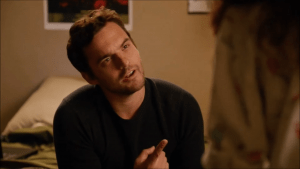The visual composition of a shot in a TV show or film acts as both the frame for the elements within the literal camera shot as well as the ideas, themes, and concepts of the piece’s director; cinematography hence becomes vital in facilitating the audience’s understanding and interaction with the meaning of the show or film. In Elizabeth Meriwether’s show New Girl, the general cinematography of each scene — namely the duration of each shot, the lighting of the scene, and visual consistency between episodes — emphasizes the dialogue and interactions between the characters and grounds these characters in a believable and relatable setting.
While cuts often mark a change or transition temporally or spatially, the quick cuts in the bulk of New Girl instead mark shifts in focus between the dialogue, emotions, and actions of certain characters to the reactions of the others in the scene. For instance, in “Wedding” (S1E3), 7 cuts between Jess, Nick, and Schmidt are made in the first 17 seconds, averaging out to be one cut every 2.4 seconds. These quick cuts, combined with the consistent setting of Nick’s room, exemplifies the purpose of the quick cuts to highlight the exchange between the three roommates, thus demonstrating the priority placed on supporting the characters’ dialogue over progressing the plot through visual storytelling.
Similarly, the bright, even lighting of the set throughout each episode also serves to focus audience attention on the characters themselves rather than the relationship between the characters and their environments.

Nick and Jess talking, S1E4

Nick and Jess talking, S1E4
screenshots are from a scene taking place at night in Nick’s room from “Naked” (S1E4) where Jess attempts to resolve the awkwardness between she and Nick after seeing him naked, the bright. The saturated lighting in these shots establishes the focus of the scene onto Jess and Nick’s interactions. Beside just creating a clear shot for the camera, the uniformity of the lighting on the two characters also creates a sense that Jess and Nick are physically close in proximity, thus helping to resolve the crisis between the friends.
In order to increase the relatability of the characters to a viewership as vast and diverse as the watchers of cable TV and Netflix, the cinematography and visual composition from episode to episode stays consistent in order to create a sense that the show’s characters live in the audience’s reality regardless of how crazy their actions and motives may be. For instance, the similar angles, lighting, and setting between the shots from episode 3 above and the shots from “Cece crashes” (S1E5) establishes a basis of normality and consistency in the characters’ lives, thus eliminating the need to suspend one’s disbelief when assessing their motivations and emotions.

Jess and Cece argue, S1E5

Jess and Cece argue, S1E5
The quick cuts, bright lighting regardless of time of day or space, and consistency of shots between episodes contribute to the focus of the show on how its characters interact with one another in a humorous way while also drawing attention towards the same feelings of joy and pain of living an ordinary life.
Netflix. “New Girl S1:E4 ‘Naked’.” Online Video Clip. Netflix. Netflix, 2018. Web. 10 September 2018.
Netflix. “New Girl S1:E5 ‘Cece Crashes’.” Online Video Clip. Netflix. Netflix, 2018. Web. 10 September 2018.
simpathy22. “Best of Jess | Season 1 | New Girl.” Online Video Clip. Youtube. Youtube, 2 March 2016. Web. 10 September 2018.

Comments are closed.